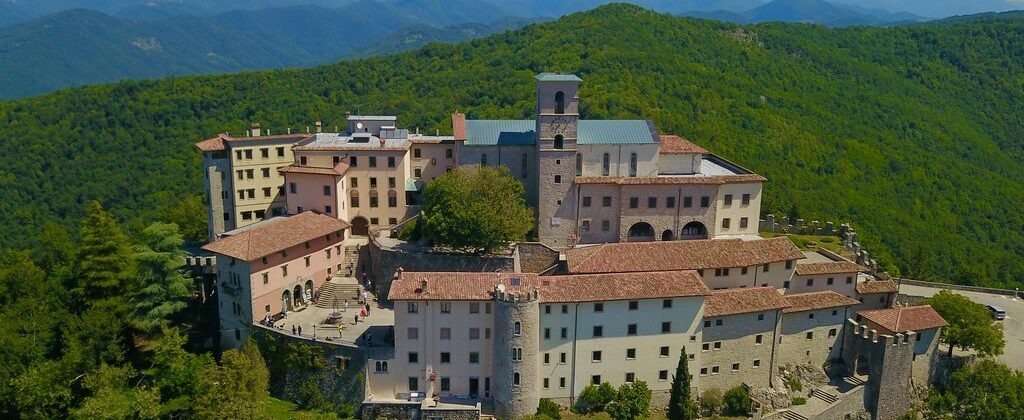The devotion to the Blessed Virgin of Castelmonte between legend and history
by Francesca Morselli
The first spiritual retreat of Alleanza Cattolica del Friuli Venezia Giulia took place on 19 November in a place rich in history, charm and spirituality: the Sanctuary of the Blessed Virgin of Castelmonte (Udine).
The sanctuary stands on top of a 618-metre-high mountain, in the Julian Pre-Alps chain, a few kilometers from Cividale del Friuli and Udine, surrounded by green woods and with an astonishing view of the peaks of the Friulian Alps, already covered with snow in this period . The atmosphere you breathe on this mountain is given by the perfect union between nature and the work of man, when men still knew how to build with the materials they found on the spot, following the natural slope of the mountains, when the buildings they integrated into the landscape naturally and indeed exalted and enriched it. Capacity that unfortunately seems difficult to find in contemporary interventions. The charm and spirituality of the sanctuary have been maintained over time and have come down to us almost intact, despite the complex events it has gone through.
The legend about the birth of the sanctuary has it that one day the devil challenged the Madonna as to which of the two was faster to reach the top of the mountain, the winner would have dominated the city of Cividale. The Madonna, pushing with her foot on a boulder, which according to legend still bears its mark, reached the top where the Archangel Gabriel was waiting for her, who chased away the devil plunging him into hell and thus opening a chasm in the place called , in fact, “bùse del Diàul” [buco del Diavolo]which can still be seen today on the nearby Mount Spich.
Moving from popular legends to history, it appears that the sanctuary was originally a Roman military post converted into a place of worship between the 5th and 7th centuries.
It seems probable that the Christian Roman soldiers of the garrison of Cividale (then “Forum Julii”) brought the signs of their faith to those places where, among other things, the Marian cult intertwined with that of the Archangel Michael they were particularly devoted (the crypt of the sanctuary is dedicated, in fact, to the warrior Archangel).
These remote origins make Castelmonte one of the oldest Marian sanctuaries in northeastern Italy, and certainly the most important in the patriarchate of Aquileia.
From the 13th century the sanctuary expanded to become a village.
On 21 September 1469 lightning struck the top of the mountain, causing the bell tower and a large part of the church to collapse; a fire then broke out which destroyed the ancient effigy of the Virgin venerated here and reduced the entire sanctuary to ruins. The reconstruction was completed in 1479, the year in which peace was concluded between the Ottoman Empire and Venice. These two anniversaries meant that on 8 September 1479 there was a “great pardon” in Castelmonte, with the participation of many pilgrims.
The current statue of the Virgin, carved in stone, therefore dates back to the first decades of the fifteenth century and is probably the work of a local craftsman.
Some details remind the faithful of the mystery she represents: the crown, the mantle and the throne on which she is sitting symbolize her royalty; her breast uncovered to breastfeed her baby that she carries in her womb reminds us that she is the mother of God and mother of the Church; Her posture recalls the image of other figures where Mary carries the body of her dead Son in her arms, but in this case she expresses her communion with God and the celebration of her life. For her youthful and attractive face, she was called “Beautiful Madonna” and for her lively and maternal attitude, still today, she is called “Madonna viva”. The motif of Mary’s dark complexion may be a reference to the Song of Songs in which the young bride says of herself: “Nigra sum, sed formosa”(Song 1,4); or, it represents an attempt to recall the image of the ancient Marian icons, of oriental tradition, which appeared dark because they were blackened by time with the smoke of the candles.
The statue is part of the tradition of black madonnas already present in various European sanctuaries (Loreto, Altoetting)”.
Since 1913 the Sanctuary has been guarded by the Capuchin Fathers who had to bear the consequences of the proximity of the sanctuary to the front during the first and also the second world war, and, finally, also the earthquakes of May and September 1976, which fortunately spared the sanctuary.
Since then, on 8 September every year, thousands of devotees, led by the archbishop of Udine, have walked up the mountain to thank the Mother of God and implore her protection.
Numerous votive offerings are kept along the walls and in the crypt and, among the pilgrims who go up to the sanctuary from all over Italy, but also from nearby Austria and Slovenia, the prayer to the Virgin of Castelmonte resounds:
Holy Virgin of Castelmonte, who always protected and defended your devotees, look with a motherly eye on us too who turn to you with so much trust. We are poor sinners, but You are our Mother. We repent of the evil we have committed and we trust in your maternal goodness.
Saturday, November 26, 2022
Related
The admirable Sanctuary of the Blessed Virgin of Castelmonte – Alleanza Cattolica

